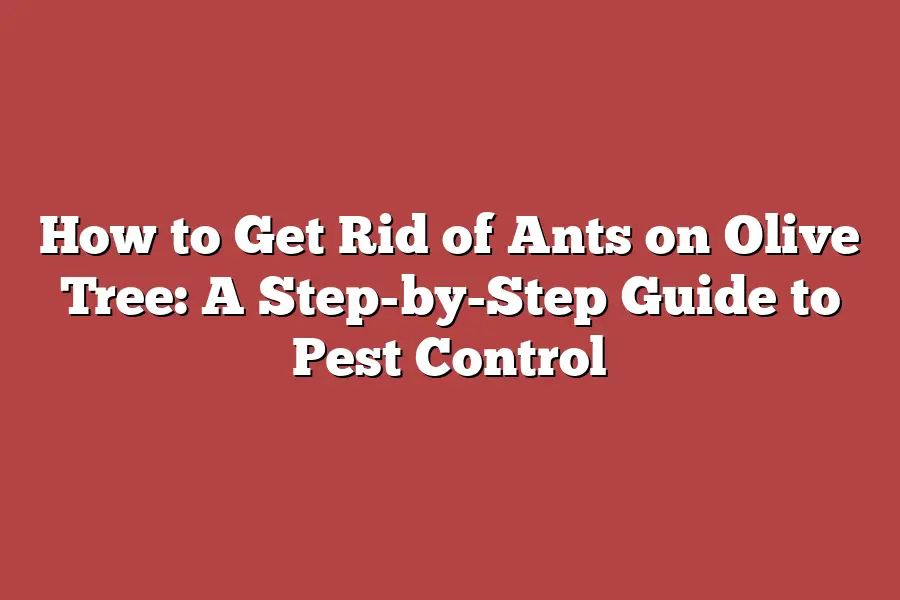To get rid of ants on an olive tree, start by removing any food sources that may be attracting them, such as sweet or sticky substances. Use a mild insecticide or essential oil-based spray to repel ants without harming the tree. If the infestation is severe, consider consulting with a gardening expert or pest control professional for guidance. Keep in mind that some ant species are beneficial to olive trees, so it’s crucial to identify the type of ant before taking action.
As an olive tree enthusiast, I’ve had my fair share of battles with pesky ants.
There’s nothing quite like watching those tiny creatures crawling up your treasured tree, leaving behind trails of destruction in their wake.
It’s a frustrating and helpless feeling, knowing that you’re powerless against these unwanted visitors.
But fear not, dear olive tree lover!
Today, I’m sharing my step-by-step guide on how to get rid of ants on your olive tree, using natural and organic methods that are safe for your plants and the environment.
From inspecting your tree to eliminating food sources and using natural deterrents, we’ll cover it all.
By the end of this post, you’ll be well-equipped to take back control of your olive tree and keep those ants at bay.
So let’s get started!
Table of Contents
Inspect Your Olive Tree
Pest control doesn’t have to be a guessing game.
When it comes to getting rid of ants on your olive tree, the first step is all about observation.
It’s time to don your detective hat and get up close and personal with your tree.
As you walk around your olive tree, take a good hard look at its bark and leaves.
Are there any tiny creatures crawling around?
This could be a sign that ants are present.
Don’t just stop at the obvious spots, though – ants can be sneaky, and they might be hiding in plain sight.
One of the most telltale signs of an ant infestation is the presence of ant trails.
These trails can be found near food sources like sweet liquids (think honey or fruit juice), pet food, or decaying matter.
If you notice a trail of tiny ants leading to a specific spot, it’s likely that they’re attracted to something tasty.
So, what should you do if you spot some unwelcome ant guests on your olive tree?
Stay tuned for the next step in our comprehensive guide to pest control – we’ll be sharing our top tips and tricks for getting rid of these pesky pests once and for all.
Identify the Ant Species: The Key to Effective Pest Control on Your Olive Tree
As an olive tree enthusiast, you’re probably familiar with the pesky problem of ants infesting your beloved tree.
But did you know that not all ant species are created equal?
In fact, some require more specialized control methods than others.
That’s why it’s crucial to identify the type of ants you’re dealing with before whipping out the pest control arsenal.
So, what kind of ants might be munching on your olive tree’s sap or sweet treats?
Let’s start by exploring two common culprits: odorous house ants and pavement ants.
Odorous House Ants: The Uninvited Guests
These little critters are known for their distinctive rotten coconut-like odor (hence the name “odorous”).
You might find them scurrying around your olive tree’s base, especially in areas with high humidity or moisture.
Odorous house ants are attracted to sweet substances like honeydew and can be quite aggressive when defending their colony.
Pavement Ants: The Underground Invaders
Pavement ants, on the other hand, prefer dry, well-drained soil and can be found burrowing beneath your olive tree’s roots or in nearby areas.
These ants are more likely to focus on protein-rich sources like insects and seeds, rather than sweet treats.
Research is Key: Understanding Ant Behavior and Preferences
Now that you know which ant species might be visiting (or overstayng) your olive tree, it’s essential to learn more about their habits and habitats.
By doing so, you’ll gain valuable insights into their behavior, diet, and preferences – all crucial information for effective pest control.
For instance:
- Do odorous house ants tend to forage at night or during the day?
- Are pavement ants more likely to be found in areas with dense vegetation or open spaces?
- What are their preferred food sources?
By answering these questions, you’ll develop a better understanding of your ant adversaries and can tailor your control strategies accordingly.
That’s it for this section!
Stay tuned for the next installment of our step-by-step guide on how to get rid of ants on olive trees.
Seal Entry Points: The First Step in Outsmarting Olive Tree Ants
When ants start taking over your olive tree, it can be a real nuisance.
But the good news is that you don’t have to resort to chemical-based pesticides or calling in a pest control professional (although, let’s be real, they’re not the most effective solutions either).
By sealing entry points and making your olive tree an ant-free zone, you’ll be well on your way to reclaiming your tree’s natural beauty.
So, where do ants typically enter and exit your olive tree?
Look for any cracks, crevices, or holes in the bark, trunk, or branches.
These tiny openings may seem insignificant, but trust me, they’re like revolving doors for ants!
By sealing these entry points, you’ll make it much harder for ants to gain access to your tree.
Now, I know what you’re thinking: “But how do I even find these pesky little entry points?” Fear not, my friend, because I’ve got a few tricks up my sleeve.
First, take a close look at the trunk and branches of your olive tree.
Are there any splits or cracks in the bark?
Any holes where twigs or branches have broken off?
If you’re still having trouble spotting those sneaky entry points, try this: grab a flashlight and shine it on the tree.
Ants are attracted to light, so if they’re entering or exiting through a particular spot, you may be able to see them scurrying in or out.
Once you’ve located those entry points, it’s time to get sealing!
You can use caulk, sealant, or patching material to fill in these gaps.
I like to use a combination of caulk and sealant – the caulk provides a strong adhesive bond while the sealant adds extra protection against the elements.
Remember, this is just the first step in getting rid of ants on your olive tree.
In my next section, we’ll explore how to eliminate ants from your tree’s soil and surrounding areas.
But for now, take pride in knowing that you’ve taken control of those pesky little entry points!
Eliminate Food Sources: The First Line of Defense Against Olive Tree Ants
As I’m sure you’ve noticed by now, ants can be a real nuisance when they show up on your prized olive tree.
But before we dive into the nitty-gritty of ant control methods, it’s essential to understand that these pesky critters are often drawn to one thing: food.
And let me tell you, there are plenty of potential food sources lurking around your garden and surrounding areas, just waiting to attract an ant infestation.
In this section, we’ll explore the importance of removing any sweet substances, pet food, or decaying matter that may be luring these unwanted visitors to your olive tree.
Sweet Substances: A Siren Song for Ants
You know the saying “you are what you eat”?
Well, ants certainly do!
When it comes to attracting ants to your garden, sweet substances like sugar, honey, and fruit can be a major draw.
And let me tell you, those little guys love ’em some sugary snacks.
In fact, did you know that ants have specialized taste receptors on their antennae that allow them to detect even the slightest hint of sweetness?
It’s no wonder they’re drawn to sweet substances like bees to honey (pun intended).
So, what can you do to eliminate this potential food source?
Here are a few simple tips:
- Store sugar and other sweet substances in sealed containers or zip-top bags.
- Keep your kitchen counters clean and free of crumbs and spills.
- Avoid leaving fruit or vegetables out on the counter for extended periods.
Pet Food: A Bonanza for Ants
If you’re an animal lover like me, you know that our furry friends can be a source of endless joy.
But when it comes to attracting ants to your garden, pet food can be a major contributor to the problem.
In fact, did you know that ants are attracted to pet food because it often contains high levels of protein and fat?
These nutrients can be a major draw for ants looking for a quick snack or meal.
So, what can you do to eliminate this potential food source?
Here are a few simple tips:
- Store pet food in sealed containers or zip-top bags.
- Keep your pet’s bowls clean and free of crumbs and spills.
- Avoid leaving pet treats out on the counter for extended periods.
Decaying Matter: A Feast for Ants
You know that old saying “one person’s trash is another person’s treasure”?
Well, ants certainly don’t discriminate when it comes to decaying matter.
In fact, they love it!
Decaying matter can provide ants with a rich source of nutrients and energy, making it an attractive food source.
So, what can you do to eliminate this potential food source?
Here are a few simple tips:
- Keep your garden and surrounding areas clean and free of debris.
- Remove any dead or decaying plants or trees from your yard.
- Avoid leaving piles of leaves or other organic matter out for extended periods.
By following these simple steps, you can help reduce the likelihood of ant infestation on your olive tree.
And remember, the key to successful pest control is to identify and eliminate potential food sources that may be attracting ants to your garden.
In our next section, we’ll explore some more advanced strategies for controlling ants on your olive tree.
But for now, let’s keep things simple and focus on eliminating those pesky little critters’ favorite snacks.
Use Natural Deterrents: The Ultimate Ant-Repellent Arsenal for Your Olive Tree
I know what you’re thinking: “Cinnamon?
Cayenne pepper?
Cloves?
Are you crazy?!” But hear me out, folks.
These natural deterrents are not only effective at keeping ants away from your olive tree, but they’re also non-toxic and environmentally friendly.
Let’s start with the big guns: cinnamon.
Now, I know what you’re thinking – “Cinnamon is for baking, not pest control!” But trust me, this sweet spice has a secret power: it repels ants!
Simply sprinkle some cinnamon around the perimeter of your olive tree, and those pesky little creatures will be none the wiser.
But don’t stop there!
Cayenne pepper and cloves are also natural deterrents that can help keep ants at bay.
And the best part?
They’re just as effective as their spicy counterpart, cinnamon!
Now, I know what you’re thinking: “What about diatomaceous earth?” Ah, my friend, this is where things get really interesting.
Diatomaceous earth (DE) is a non-toxic powder that’s been used for centuries to control pests.
And when it comes to ants, DE is like the ultimate ninja – sneaky, silent, and deadly.
Here’s how it works: ants are attracted to sweet or sticky substances, so they’ll be drawn to the DE particles.
But once they touch them, their exoskeletons will dehydrate and die.
It’s like a tiny little ant-sized vacuum cleaner for those pesky insects!
So there you have it – natural deterrents that are guaranteed to keep ants off your olive tree.
And the best part?
They’re non-toxic, environmentally friendly, and won’t harm any beneficial insects (like bees or butterflies).
Now, go forth and conquer those ants like a pro!
Consider Organic Pest Control Methods
I know what you’re thinking – why bother with organic pest control methods when there are plenty of “stronger” chemicals out there?
Well, let me tell you, friend.
As someone who’s spent countless hours researching and experimenting with olive tree care, I can attest that going the organic route is not only better for the environment, but it’s also a more effective way to get rid of ants on your precious trees.
Think about it – when you use harsh chemicals to kill ants, you’re not just killing those pesky little critters.
You’re also poisoning the soil, the air, and even the water around them.
And let me tell you, that’s not exactly the kind of legacy I want to leave behind.
Not to mention, those chemicals can actually do more harm than good in the long run.
That’s why I’m a huge proponent of using organic pest control methods like neem oil, pyrethrin, and insecticidal soap.
These natural wonders are specifically designed to target ants (and other pests) without harming the environment or your olive tree.
Neem Oil: The Unsung Hero of Organic Pest Control
Neem oil is one of those magic bullets that can tackle a wide range of pest problems – including ants!
It works by disrupting the ants’ ability to communicate with each other, essentially rendering them unable to coordinate their attacks.
And the best part?
It’s completely non-toxic and biodegradable.
Pyrethrin: The Natural Insecticide
Pyrethrin is another natural insecticide that’s specifically designed to target insects like ants.
It works by disrupting the ants’ nervous system, essentially paralyzing them.
And the best part?
It’s a natural compound found in the flowers of the pyrethrum daisy.
Insecticidal Soap: The Gentle Giant
Insecticidal soap is another gentle giant that’s specifically designed to target insects like ants.
It works by suffocating the ants, essentially dehydrating them.
And the best part?
It’s a mild detergent that won’t harm your olive tree or the environment.
So there you have it – three natural and effective ways to get rid of ants on your olive tree without resorting to harsh chemicals.
Just remember to always read and follow label instructions for any chemical products you use, and take necessary precautions to avoid exposure.
And if you’re still having trouble getting rid of those pesky little critters, don’t worry – I’ve got more tips and tricks up my sleeve!
Stay tuned for the next installment of this step-by-step guide on how to get rid of ants on your olive tree.
Final Thoughts
As I reflect on the steps we’ve covered to get rid of ants on our beloved olive tree, I’m reminded that effective pest control is all about understanding the little critters’ habits and preferences.
By inspecting your tree, identifying the ant species, sealing entry points, eliminating food sources, using natural deterrents, and considering organic methods – you’ll be well on your way to a healthier, ant-free olive tree.
It’s not just about wiping out the pests, but also about creating an environment that discourages them from returning in the first place.
With these simple yet powerful strategies, you’ll be enjoying the fruits of your labor (literally!) without those pesky ants getting in the way.


